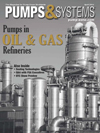Insight and reactions to key industry coverage
"April-Wise Pump Quiz: NPSH and Developed Head," April 2011
Click here for the full article.

I read your April 2011 quiz and kept looking for the answers in a subsequent article by you. It was not until I contacted the magazine editor that I found that the answer was in the Reader’s Response section of the May 2011 issue. The answers raised several questions. Attached are my calculations which I did not turn in, but probably should have.
According to the books and tables I have, the vapor pressure of water at 80 F is 1.17 feet rounded off to 1.2 and not 1.6 feet. At 90 F the vapor pressure is 1.6 feet. Are my tables wrong?
Second I calculate the velocity head in the 3-inch suction pipe at a velocity of 9.07 feet per second or at 9.1 feet per second as 1.3 feet and not 1.2 feet. I know these are minor differences and do not impact the final answer significantly but wanted your comments. Thanks.
Chuck Anderson
Lev Nelik responds:
Thank you, Chuck. You make some very good points. I did approximate the numbers, which is why you have a bit of discrepancy. Typically, for the purpose of a quiz like this one, I would use a 3-inch pipe inside diameter to calculate the net area. To be exact, a 3-inch pipe has a diameter somewhat different than the exact 4 inches, and it also depends on the pipe schedule.
The same applies to the approximation on vapor pressure. I have several other people with similar feedback. So don’t worry—you did not miss anything. In fact, you picked up a few fine points in the calculations and had good thinking.
Glad to see you are paying close attention to the detail! Good work – congratulations on your efforts, and keep on pumping!
"The History of Pumps," January 2012
Click here for the full article.

I was reading your magazine, as usual, and came across your “History of Pumps” and found it quite interesting. Dorr-Oliver was primarily a process equipment company during the last century, but in the course of events, it developed several pumps to feed its process equipment in a more efficient and cost effective manner. I have attached some of them here for possible inclusion in your online history list.
I assumed that you would not just take my word for it so I have also attached some serial records for proof and a current brochure on these same products. Some are still the same, but the centrifugals have morphed though the years. I believe it may have been the first to be a cast iron elastomer lined centrifugal pump for use in acidic slurry transfer in the minerals process industry.
The last attachment is the history of the Dorr-Oliver company. For this e-mail specifically, the year 1916 lists that the first DORRCO suction pump was built for the minerals process industry, and the serial page lists that year for that style.
1921 lists the development of the OLIVITE series of centrifugals for slurry transfer.
1939 lists the development of the Oliver diaphragm slurry (ODS) pump for slurry transfer. It is a single acting, positive-displacement, air-operated diaphragm pump. Way before Warren-Rupp or Wilden came on the scene. Originally designed for mining slurry transfer with their associated acids, it developed into an exceptional primary sludge underflow pump for the wastewater industry starting in the 1970s after the Clean Water Act took place and exploded that industry’s activities. Unfortunately the Dorr-Oliver name was dropped from use by the current owners of the products on January 1, 2010. If you have any questions, I am at your service.
Dan O'Connor, Products Manager
Dorr-Oliver Pump
Michelle Segrest responds:
Thank you for this important information. We have added the information to our online "History of Pumps: Through the Years" timelines on www.pump-zone.com.

